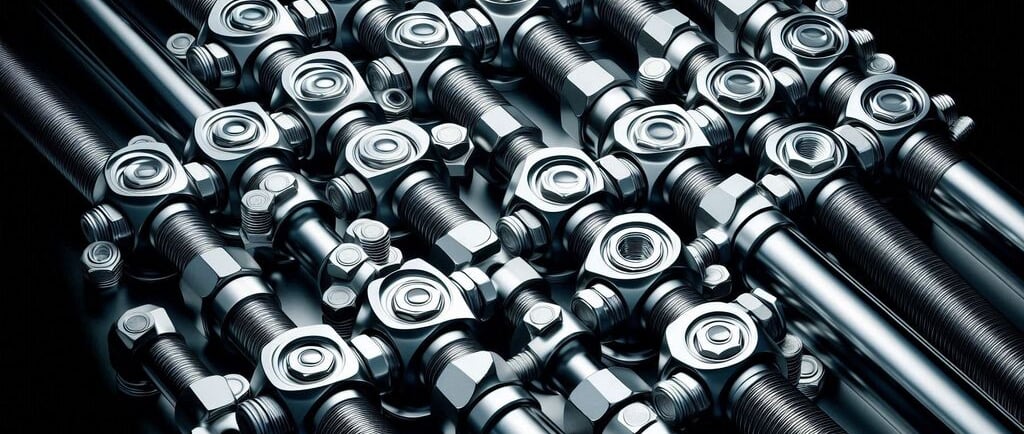Connecting Rods
When you think about the parts that make an engine run smoothly, the usual suspects might include the pistons, crankshaft, and camshaft.
ENGINE COMPONENTS
11/13/20244 min read


Connecting Rods: The Unsung Heroes of Engine Performance
When you think about the parts that make an engine run smoothly, the usual suspects might include the pistons, crankshaft, and camshaft. But there's one crucial component that often goes unnoticed—the connecting rod. This seemingly simple piece plays a vital role in converting the pressure from combustion into mechanical work, ensuring your engine operates efficiently and reliably. Whether you're a car enthusiast, mechanic, or just someone who wants to understand how engines work, it's time to shine a light on connecting rods.
What Are Connecting Rods?
At their core, connecting rods are metal components that link the piston to the crankshaft. They are an essential part of an engine's reciprocating assembly, converting the linear motion of the piston into rotary motion to power your vehicle. Without a strong and durable connecting rod, your engine wouldn’t function properly, which could lead to performance issues or even catastrophic failure.
The Anatomy of a Connecting Rod
A typical connecting rod has three main parts:
Big End: The part that attaches to the crankshaft.
Small End: The part that connects to the piston.
Rod Body: The long, connecting part that links the big and small ends.
Each of these components must be precisely engineered to handle the extreme forces at play within an engine.
Types of Connecting Rods
Not all connecting rods are created equal. Depending on the type of engine and the performance needs, connecting rods come in different styles and materials. Here are the most common types:
1. Forged Connecting Rods
Forged rods are made by shaping a solid piece of metal using heat and pressure, resulting in a stronger and more durable rod. These are often used in high-performance engines where strength is a top priority.
2. Cast Connecting Rods
Cast rods are created by pouring molten metal into a mold and letting it cool. While not as strong as forged rods, they are more affordable and are typically used in regular consumer vehicles where high performance isn’t the primary concern.
3. Billet Connecting Rods
Made from a single block of metal, billet rods are custom-machined for high-end applications. They are the go-to choice for racing engines and other high-performance setups due to their superior strength and reliability.
Common Materials for Connecting Rods
The material used to make connecting rods plays a significant role in their performance and durability. Some of the most commonly used materials include:
Steel: A popular choice for standard connecting rods, steel offers a good balance of strength and cost.
Aluminum: Lightweight and affordable, aluminum is often used in cast rods for non-performance engines.
Titanium: Known for being both light and extremely strong, titanium is used in high-performance applications but comes at a higher cost.
How Connecting Rods Affect Engine Performance
A connecting rod directly impacts an engine’s performance. Here’s how:
Strength and Durability: A high-quality rod ensures that the engine runs smoothly for longer, reducing the risk of failure and the need for costly repairs.
Weight: Lighter rods help reduce engine drag, allowing for faster RPMs and better fuel efficiency.
Precision: Even the slightest imperfection in the connecting rod can lead to vibrations or other performance issues, so high-quality rods ensure that everything runs smoothly.
Performance Implications of Connecting Rods
In racing engines, for instance, a forged or billet rod might be the best option because of the stresses the engine undergoes at high RPMs. For daily drivers, however, cast or aluminum rods are often sufficient, offering a good balance of performance and cost.
How to Maintain Your Connecting Rods
Maintaining your connecting rods is essential to keeping your engine running in top condition. Here are a few tips:
Regular Inspections
Regularly check your engine’s oil to ensure it’s clean and free from debris. Dirt and contaminants can cause wear on the connecting rods, leading to failure over time.
Keep Your Engine Well-Lubricated
Lubrication is key to reducing friction between the piston and connecting rod. Always follow your vehicle’s maintenance schedule and use the recommended oil type.
Watch for Warning Signs
If you hear knocking sounds or notice a loss of power in your engine, these could be signs that your connecting rods are damaged. It's crucial to address these issues immediately to prevent further damage.
When to Replace Connecting Rods
Replacing a connecting rod isn’t something most people think about until there’s an issue, but knowing when to replace one can save you a lot of time and money. Some signs that it’s time to replace the connecting rod include:
Excessive Engine Noise: A knocking or tapping sound could indicate that the rod is damaged.
Low Oil Pressure: Damaged rods can lead to oil leaks or low pressure, which might require immediate attention.
Engine Misfires: If your engine is misfiring or struggling to maintain smooth operation, a faulty connecting rod could be the cause.
Conclusion
Connecting rods are a vital, yet often overlooked, part of your engine. Whether you’re building a high-performance race car or simply maintaining your daily driver, understanding the role of connecting rods will help you make better decisions regarding performance and maintenance. Remember, a strong and reliable connecting rod can make a world of difference in how well your engine performs. So, if you're ever considering upgrades or repairs, don’t underestimate the importance of this essential component.



